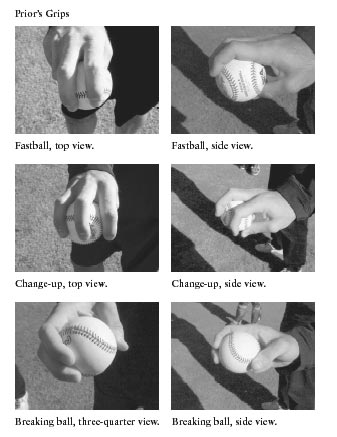 In the intricate world of baseball pitching, mastering the art of offspeed pitches is akin to unlocking a treasure trove of strategic advantages. These deceptive deliveries serve as a pitcher's clandestine arsenal, capable of confounding even the most seasoned batters, disrupting their timing with finesse, and ultimately transforming an average hurler into a formidable adversary on the mound.
In the intricate world of baseball pitching, mastering the art of offspeed pitches is akin to unlocking a treasure trove of strategic advantages. These deceptive deliveries serve as a pitcher's clandestine arsenal, capable of confounding even the most seasoned batters, disrupting their timing with finesse, and ultimately transforming an average hurler into a formidable adversary on the mound.
But what exactly constitutes an offspeed pitch, and why are these maneuvers deemed indispensable in a pitcher's repertoire? Offspeed pitches, as their name suggests, deviate from the typical velocity that hitters expect, offering a wide variety of slower-than-average offerings meticulously designed to trick and outwit opponents. From the subtle changeup to the sweeping curveball, each offspeed pitch boasts its own unique movement patterns and grip configurations, adding layers of complexity and intrigue to the pitcher's craft.
Delving deeper into the realm of offspeed pitches unveils a rich tapestry of nuanced techniques and strategic considerations. Pitchers must master the subtle art of disguise, seamlessly blending these slower offerings into their repertoire to catch hitters off guard and disrupt their rhythm. With meticulous attention to grip, release, and execution, pitchers can manipulate the trajectory and movement of offspeed pitches, creating a mesmerizing dance of deception on the diamond.
In essence, offspeed pitches serve as a potent weapon in a pitcher's arsenal, offering a strategic advantage that extends far beyond sheer velocity. By mastering the intricacies of these deceptive deliveries, pitchers can gain the upper hand against even the most formidable opponents, elevating their game to new heights of excellence and dominance on the mound.
Types of Offspeed Pitches in Baseball
 Changeup
Changeup
The changeup is perhaps the most ubiquitous offspeed pitch in baseball. It mimics the arm action of a fastball but is significantly slower, often with a downward movement. Pitchers vary the grip and release to achieve different speeds and movements, making it a versatile weapon against aggressive hitters.
 Slider
Slider
The slider is a lateral-breaking pitch that combines speed with deception. It appears as a fastball out of the pitcher's hand but veers sharply to one side as it approaches the plate. Mastering the slider requires precise control and consistent mechanics to avoid telegraphing the pitch to observant batters.
 Curveball
Curveball
Known for its looping trajectory, the curveball is a classic offspeed pitch favored by many pitchers. It features a pronounced downward break, making it particularly effective against hitters expecting high-speed fastballs. Grip variations and wrist action play crucial roles in dictating the curveball's movement and effectiveness.
 Splitter
Splitter
The splitter, also known as the split-finger fastball, combines elements of a fastball and a forkball. It features late downward movement akin to a forkball but is thrown with fastball arm speed. The split grip creates deception, making it challenging for hitters to differentiate from a fastball until it's too late.
 Knuckleball
Knuckleball
The knuckleball is an enigmatic pitch characterized by its lack of spin and unpredictable movement. Gripped with the fingertips rather than the seams, it flutters and dances on its way to the plate, confounding even the most seasoned hitters. Mastering the knuckleball requires exceptional touch and finesse.
 Forkball
Forkball
Similar to the splitter, the forkball is a deceptive pitch designed to mimic a fastball until the last moment. It features a split grip with the index and middle fingers spread apart, creating downward movement and inducing swings and misses from unsuspecting batters.
Grips and Mechanics: Offspeed Pitches in Baseball
Perfecting offspeed pitches requires a deep understanding of grip variations and mechanics. Pitchers experiment with different grips to achieve desired movement and deception. Release points, arm angles, and wrist action all influence the trajectory and effectiveness of offspeed deliveries.
Effectiveness and Strategy: Offspeed Pitches in Baseball
The effectiveness of offspeed pitches lies in their ability to keep hitters off balance and guessing. Pitchers strategically mix these pitches with fastballs to disrupt timing and location, keeping hitters guessing and off-balance. Hiding pitches until the last moment and mastering count management are essential components of a successful offspeed strategy.
Training Offspeed Pitches: Offspeed Pitches in Baseball
Training offspeed pitches involves honing grip, release, and consistency through dedicated drills and practice sessions. Developing a repeatable motion and mental approach is crucial for maintaining confidence and executing pitches under pressure.
Injury Prevention and Management: Offspeed Pitches in Baseball
While offspeed pitches offer a potent weapon for pitchers, they also carry risks of overuse and injury. Implementing proper strengthening exercises, recovery protocols, and workload management strategies are essential for mitigating these risks and ensuring long-term pitching health.
Advanced Techniques: Offspeed Pitches in Baseball
Advanced pitchers employ sophisticated techniques such as tunneling and pitch sequencing to enhance the effectiveness of offspeed pitches. By disguising pitch intentions and exploiting hitter tendencies, pitchers gain a strategic advantage on the mound, maximizing their repertoire's effectiveness.
TopVelocity Pitch Analytics Products and Services
 THE MOST ADVANCED BASEBALL PITCHING GRIPS ANALYSIS AVAILABLE!
THE MOST ADVANCED BASEBALL PITCHING GRIPS ANALYSIS AVAILABLE!
Are your pitches not as effective as you'd like them to be? Do you find it challenging to determine the best pitch combination for your repertoire? Look no further than TopVelocity's Pro Pitching Grips Analytics. Designed to cater to athletes of all experience levels, our analytics service offers the guidance you need when progress has stalled. Here's what you can expect from Pro Pitching Grips Analytics:
- Individual Pitch Analysis: Gain insights into the performance of each of your pitches, including their movement, velocity, and effectiveness.
- Opportunities for Improvement: Identify areas where you can enhance your pitching arsenal and make meaningful improvements to your game.
- Major League Pitch Grade: Compare your pitches to those of elite athletes and understand how you stack up against the competition.
Don't hesitate any longer—get your analysis now and take your pitching to the next level!
LET PRO BASEBALL PITCHING GRIPS ANALYTICS BE YOUR ACE IN THE WHOLE! (REQUIREMENTS FOR PLAYER ANALYSIS)
To conduct a thorough analysis with TopVelocity Pro Pitching Grips Analytics, you'll need at least three pitches of each pitch type. These pitches should closely match your average or peak velocity and locations. While CSV files are preferred, we also accept screenshots or pitch/bullpen reports.
 Pitching Grips Video Analysis
Pitching Grips Video Analysis
For players seeking a deeper dive into their pitching arsenal, TopVelocity offers Pitching Grips Video Analysis. With this service, you'll get all the same great information from our data analysis in addition to a thorough analysis of your pitching grips and ball release using high-speed video footage you provide.
Having access to detailed information about your baseball release and pitching grip allows our analytics team to provide a more thorough breakdown. We can offer deeper insights and more detailed pitch recommendations tailored to your unique style and goals.
Note: High-speed camera footage should be captured directly from behind the pitcher's hand from a second base position. The video must be clear and have a minimum frame rate of 480 FPS.
DATA AND VIDEO ANALYSIS AVAILABLE FOR INDIVIDUALS, TEAMS, AND ENTIRE FACILITIES.
Pricing For Programs Are A ONE-TIME FEE
- TopVelocity Pitch Data Analysis (Single Analysis):
- Summary of your pitch data
- Individual pitch analysis
- Major League pitch grade
- Major League pitch comparison
- Pointers for improvement
- Pitch target recommendations
- Pitching tips
- Analytic language breakdown
- Pitch notes
- TopVelocity Pitch and Video Analysis:
- All features of Pitch Data Analysis, plus Video Analysis for a deeper dive into pitching mechanics.
- 5 TopVelocity Pro Pitch Analytics:
- Prepare for the future with a bundle deal that includes five analyses at a discounted rate.
- 5 TopVelocity Pro Pitch Analytics and Video Analysis:
- Combine the benefits of Pro Pitch Analytics with Video Analysis for comprehensive insights into your pitching performance.
With TopVelocity's Pitch Analytics Products and Services, you'll gain valuable insights and recommendations to elevate your pitching game to new heights.
FAQs: Offspeed Pitches in Baseball
- How can I improve my offspeed pitch? Improving your offspeed pitch requires a combination of practice, technique refinement, and mental focus. Start by perfecting your grip and release mechanics for the specific offspeed pitch you're working on, whether it's a changeup, slider, curveball, or another variation. Spend dedicated time in bullpen sessions or practice games focusing solely on your offspeed repertoire. Additionally, seek feedback from coaches or experienced pitchers to identify areas for improvement and adjust accordingly. Visualize success and trust in your ability to execute the pitch with confidence.
- What is the best grip for a changeup? The best grip for a changeup varies depending on individual comfort and pitching style. However, a common grip for the changeup involves holding the ball with three fingers—typically the index, middle, and ring fingers—while tucking the thumb slightly underneath. The key is to maintain a loose grip and minimize tension in the hand to generate maximum arm speed and deception. Experiment with different grip variations to find what works best for you and produces the desired movement and speed differential from your fastball.
- Can offspeed pitches cause arm injuries? While offspeed pitches themselves don't inherently cause arm injuries, improper mechanics, overuse, and poor pitch management can contribute to arm strain and injury risk. It's essential to maintain proper throwing mechanics, including a smooth delivery and consistent release point, to reduce stress on the arm. Additionally, pitchers should adhere to workload management protocols, avoid excessive pitch counts, and prioritize rest and recovery to prevent overuse injuries. Strengthening exercises targeting the shoulder and elbow can also help mitigate injury risk and promote long-term pitching health.
- How do I know which offspeed pitch to throw in different situations? Selecting the appropriate offspeed pitch depends on various factors, including the count, hitter tendencies, game situation, and your own pitching strengths. Consider the hitter's weaknesses and preferences, as well as your confidence in executing each offspeed pitch effectively. For example, a batter with a tendency to chase low pitches may be vulnerable to a well-executed curveball or splitter. Pay attention to the game situation and adjust your pitch selection accordingly to keep hitters off balance and maximize your chances of success.
- Are there any mental tips for throwing effective offspeed pitches under pressure? Mental preparation is crucial for executing offspeed pitches under pressure. Visualize yourself successfully executing each offspeed pitch in various game scenarios, reinforcing positive outcomes and building confidence in your abilities. Focus on staying relaxed and maintaining a consistent mental approach, regardless of the situation. Embrace the challenge and trust in your preparation and practice to carry you through high-pressure moments. Remember to breathe deeply and stay present, focusing on the task at hand rather than getting caught up in external distractions.
- What is the most challenging aspect of mastering offspeed pitches for pitchers? One of the most challenging aspects of mastering offspeed pitches is achieving consistency and command. Unlike fastballs, which rely primarily on velocity and location, offspeed pitches require precise control of movement and deception. It takes time and dedication to develop the muscle memory and feel necessary to consistently execute offspeed pitches with accuracy and effectiveness. Additionally, pitchers must learn to adjust their approach based on game situations and hitter tendencies, adding another layer of complexity to mastering offspeed repertoire. With patience, practice, and perseverance, pitchers can overcome these challenges and unlock the full potential of their offspeed arsenal.
For more exclusive content, visit TopVelocity Patreon!


 Pitching Grips Video Analysis
Pitching Grips Video Analysis